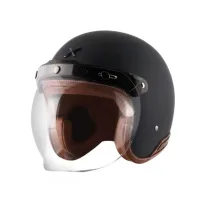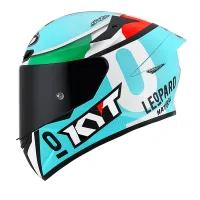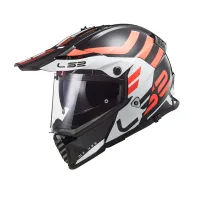Why you should wear a Helmet?
A good helmet is a must have thing for all motorcyclists. Whether you ride a motorcycle or a scooter, ride to office or on weekends, you need a helmet. If you value your head, then wearing a helmet is a must irrespective of what you ride, where you ride and how fast or slow you ride. Accidents can happen anywhere and a good helmet can save you from a catastrophic injury.
Types of Helmets:
Now that we know that Helmets are for protection (and not for just avoiding challans), it is imperative that you choose a helmet that is protective, suitable for your purpose, fits well and is comfortable. There are different types of helmets available & its necessary to understand them so that you can chose the right one:
The Right Helmet should ALWAYS Fit Well! If it is loose, lose it.
Kaustubh Thengodkar
1. Open Face & Half Face Helmets
Open face helmets are open type helmets which cover your face from top and sides, while the half face helmets only covers the top. There is a visor to cover your face and these helmets generally provide excellent ventilation. They however don’t provide any sort of protection to your face leaving one vulnerable to facial injuries. They can be noisy, don’t stop dust & dirt completely & also offer high wind resistance as the riding speeds go up. Many choose these types of helmets for nearby rides however we highly don’t recommend them for any sort of riding due to their low protection they offer.
Pros:
– Good ventilation
– Easy to use
– Lightweight
Cons:
– Not safe enough
– Low protection against dust & dirt

2. Full Face Helmets
Full face helmets are the best in terms of protection as they cover the head from all sides – top, sides and front. A distinguishing feature of such helmet is the chin bar which guards the chin and jaw against potential impact in case of an accident. Studies indicate that the chin encounters more than 50% of severe impacts during a crash, and only a full-face helmet can protect effectively in such case.
Pros:
– Best in terms of safety
– Low wind noise
– Comparatively good protection against dust and dirt
Cons:
– Can be claustrophobic for some
– Field of view can be restricted in certain helmets

3. Modular Helmets / Flip-up Helmets
Flip-up helmets also called Modular helmets are an amazing combination of full-faced and regular helmets, allowing the visor and chin bar to flip up and reveal the helmet’s front. They are made with the same materials and fitment as a full-face helmet. Modular helmets are popular with adventure and sport touring riders. They are versatile as you can grab a bite to eat, smoke a cigarette, talk to a friend or get some air without removing the helmet. Just flip up the chin bar and you are as free as wearing an open face helmet.
There is a popular notion that flip-up helmets are not safe but it would be incorrect to say so. Yes, the flip up 2-piece shell is not as strong as a full face 1 piece shell but a good certified flip-up helmet is perfectly fine for use especially for touring. Many riders globally use modular helmets for touring worldwide riding motorcycles. Unless you are doing high speed rides or riding on the track, the use of modular helmets is safe enough.
Pros:
– Easy to use due to flip up construction
– Perfect for riders wearing spectacles or eyeglasses (don’t need to remove them every time)
Cons:
– Heavier than a full-face helmet
– Not safe to ride when the chin bar is up

4. Motocross Helmets / MX Helmets / Off-road Helmets
Off-road Helmets or MX helmets as the name suggests are made for off-road or dirt riding only. They are designed for maximum protection, minimum weight and maximum ventilation. They have a certain distinguishing feature like a large peak on top (for sun & roost protection), protruded & pointy chin bar and absence of a visor. Riders have to use compatible MX goggles to protect themselves from dust and dirt. They come in bright colours and attractive graphics. You would be easily tempted to buy one however you cannot ride with these helmets on roads / highways. The absence of a visor makes them noisy as well as leaving no protection against dust and dirt. The peek will also create significant resistance at higher speeds thereby creating a strain on your neck. As said earlier, these are specifically made for a certain purpose and therefore cannot be used for any other types of motorcycle riding.
Pros:
– Lightweight with good ventilation & wide vision
Cons:
– Cannot be used for any other purpose except off-road/dirt riding

5. Dual Sport Helmets / Crossover Helmets / Enduro Helmets
Dual Sport Helmets (also known as Enduro Helmets) are a combination of full face and off-road helmets and offer the best of the both. They look similar to off-road helmets – will have a sun peek & protruded chin bar (but not as prominent as off-road helmet). The biggest difference is that they come with a visor which can be easily removed to accommodate MX goggles. The peak can be removed too & convert it to a full-face helmet The advantage is that you can wear this helmet on road as well as for light off-road or trails. These kinds of helmets are popular with adventure or enduro riders who would like to ride on different type of terrains.
Pros:
– Good ventilation & wide vision
– Peak provides sun protection
– Flexibility to remove visor and use MX goggles
– Can be used for riding on almost all kinds of terrains
Cons:
– Weight is more than the full face helmets
– May have higher wind noise

Other factors to consider while choosing a helmet:
Materials – Helmets are made of different materials and they decide the strength of the shell & the weight. The most common 4 types are listed here.
Thermoplastic – Basically hot plastic moulded into a helmet shell. Is cheap to manufacture in high quantities and has decent strength.
Fiber Glass – Helmet shells made of fiber glass will be lighter and stronger than the Thermoplastics
Composite – Many manufacturers mix materials to get best strength at lightest weight. Composite helmets would be the best bet in terms strength vs price
Carbon Fiber – Helmets made of carbon fiber layers are extremely light and are extremely strong. Most of the extreme sports like Moto GP riders will always prefer using such helmets. However they are considerably expensive over all other materials.
Balance – This is a point that not many will tell you about. A good helmet will have the right balance (weight management & aerodynamics) so that you wont feel any strain while riding it especially at higher speeds. A reputed helmet manufacturer will invest in testing the helmet to get a perfect balance.
Fit – Whatever helmet you like, ensure it fits your head properly. Always try the helmet before buying as the helmet sizes may vary from brand to brand. Try the helmet on and adjust its strap. The strap should be tight enough that only two fingers will fit between the strap and the bottom of your chin. You should not feel any gaps around your head, and the helmet should not be so tight that it’s uncomfortable. You should wear the helmet for a handful of minutes to get the feel of it, and while wearing it, you should attempt to move it around with your hands. Your cheeks should move as you move the helmet, but the helmet shouldn’t rotate or move in any direction without moving your head.
Type of securing mechanism –
Rachet – Micrometric rachet mechanism is the most commonly used helmet securing mechanism. Its easy to use especially after wearing gloves. However they are not completely failproof as in case of an accident the rachet may open. With modern day design and technology, the chances of this happening have reduced considerably.
D-Ring – These are just 2 simple D shaped rings used to secure the helmet straps and are considered the most safe. If you ride fast or on track, then D rings are the best option.
Sun-visor or internal drop down visor – Many helmets feature a sun-visor inside the main visor. This is good feature to ride on a bright sunny day especially when you are facing the sun.
Antifog protection – Helmet visors come with many antifog solutions like Pinlock or Raleri where there is an additional layer of film on the inside of the visor. These are must have as you wont be able to ride with a helmet which fogs up frequently.
Anti-scratch visor – A good helmet will come with this feature so that the visor lasts significantly long. Scratched visor will impair the rider’s vision and might not be safe too.
Compatibility with Bluetooth Intercom devices – Most of the riders will need to add devices like Bluetooth intercom to stay connected with near and dear ones. Do check if the helmet has pockets for intercom speakers.
Availability of spares in future – An important point to consider while buying any helmet is to check availability of spares in future. Its common for items like visor and internal padding to wear off with usage. The other way would be to just buy a spare along with the helmet.
Conclusion:
-
- Invest in a good helmet as you will use it at least for 5 years.
-
- Always try the helmet before buying.
-
- Check for fit, weight and other features provided.
-
- Never ride without a helmet.
What helmet brands are currently available with ISI certifications?
Currently the most prominent brands in India with ISI certifications are MT, LS2, Axor, SMK and KYT are available. These brands are available at Gear & Throttle House.
Can I use a 10-year-old helmet?
No. The materials and resin included in the helmet’s structure will deteriorate and wear down over time – regardless of whether you use them. It would be best to purchase a new one after 5-7 years (counted from the production dates).